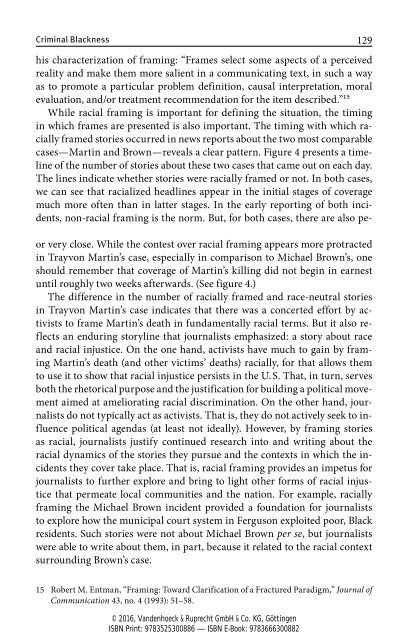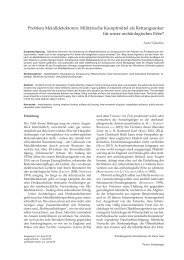Media and Minorities
9783666300882_ruhrmann_media_ebook_034247
9783666300882_ruhrmann_media_ebook_034247
You also want an ePaper? Increase the reach of your titles
YUMPU automatically turns print PDFs into web optimized ePapers that Google loves.
Criminal Blackness 129<br />
his characterization of framing: “Frames select some aspects of a perceived<br />
reality <strong>and</strong> make them more salient in a communicating text, in such a way<br />
as to promote a particular problem definition, causal interpretation, moral<br />
evaluation, <strong>and</strong>/or treatment recommendation for the item described.”15<br />
While racial framing is important for defining the situation, the timing<br />
in which frames are presented is also important. The timing with which racially<br />
framed stories occurred in news reports about the two most comparable<br />
cases — Martin <strong>and</strong> Brown — reveals a clear pattern. Figure 4 presents a timeline<br />
of the number of stories about these two cases that came out on each day.<br />
The lines indicate whether stories were racially framed or not. In both cases,<br />
we can see that racialized headlines appear in the initial stages of coverage<br />
much more often than in latter stages. In the early reporting of both incidents,<br />
non-racial framing is the norm. But, for both cases, there are also peor<br />
very close. While the contest over racial framing appears more protracted<br />
in Trayvon Martin’s case, especially in comparison to Michael Brown’s, one<br />
should remember that coverage of Martin’s killing did not begin in earnest<br />
until roughly two weeks afterwards. (See figure 4.)<br />
The difference in the number of racially framed <strong>and</strong> race-neutral stories<br />
in Trayvon Martin’s case indicates that there was a concerted effort by activists<br />
to frame Martin’s death in fundamentally racial terms. But it also reflects<br />
an enduring storyline that journalists emphasized: a story about race<br />
<strong>and</strong> racial injustice. On the one h<strong>and</strong>, activists have much to gain by framing<br />
Martin’s death (<strong>and</strong> other victims’ deaths) racially, for that allows them<br />
to use it to show that racial injustice persists in the U. S. That, in turn, serves<br />
both the rhetorical purpose <strong>and</strong> the justification for building a political movement<br />
aimed at ameliorating racial discrimination. On the other h<strong>and</strong>, journalists<br />
do not typically act as activists. That is, they do not actively seek to influence<br />
political agendas (at least not ideally). However, by framing stories<br />
as racial, journalists justify continued research into <strong>and</strong> writing about the<br />
racial dynamics of the stories they pursue <strong>and</strong> the contexts in which the incidents<br />
they cover take place. That is, racial framing provides an impetus for<br />
journalists to further explore <strong>and</strong> bring to light other forms of racial injustice<br />
that permeate local communities <strong>and</strong> the nation. For example, racially<br />
framing the Michael Brown incident provided a foundation for journalists<br />
to explore how the municipal court system in Ferguson exploited poor, Black<br />
residents. Such stories were not about Michael Brown per se, but journalists<br />
were able to write about them, in part, because it related to the racial context<br />
surrounding Brown’s case.<br />
15 Robert M. Entman, “Framing: Toward Clarification of a Fractured Paradigm,” Journal of<br />
Communication 43, no. 4 (1993): 51–58.<br />
© 2016, V<strong>and</strong>enhoeck & Ruprecht GmbH & Co. KG, Göttingen<br />
ISBN Print: 9783525300886 — ISBN E-Book: 9783666300882







